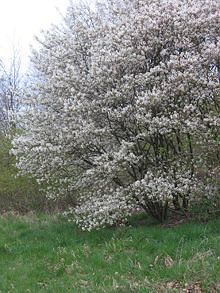Learn how to grow serviceberry trees including information on varieties for the best fruit.
Listen to podcast:
Other Name
Juneberry
Sun Requirements
Full sun, part sun, part shade
Bloom Period and Seasonal Color
Early spring with white flowers, summer with blue fruits and good orange and red fall foliage color
Mature Height x Spread
15 to 30 feet x 8 to 15 feet
Added Benefits
Native, edible, attracts beneficials, fall color, deer resistant
Serviceberry is one of my favorite, under appreciated, small trees. But I’m happy to see many are realizing the beauty and multiple benefits this tree offers. This small, multi-stemmed, native is one of the first trees to bloom in the forest in spring. Its white flowers contrast well with the new coppery-colored foliage. They give way to blue-black berries that are edible and birds love them, too. In fall the foliage turns a combination of yellow, orange and red colors. In winter the smooth, light gray bark is a nice contrast with the red stems of native dogwood bushes. This tree tolerant some shade, poor soils, and wet conditions. Newer selections feature shorter more shrub-like plants with large, blueberry-size fruits.
When, Where and How to Plant
Serviceberry is hardy throughout New England. Grow serviceberry trees purchased from a local nursery and plant from spring to early fall in moist, well-drained soils. It will tolerate wet sites and transplants easily. Serviceberry flower and fruit best in full sun, but tolerate some shade. Space plants 12 to 15 feet apart, or group trees closer together to form a thicket.
Growing Tips
Grow serviceberry trees in areas with moist soils. Water young trees well and mulch around the base of trees planted in lawns with bark mulch or wood chips to keep the soil moist. Fertilize young plants in spring with compost or a tree plant food. Older trees don’t generally need fertilization.
Regional Advice and Care
Serviceberry can be pruned into a small tree on a single trunk, or allowed to grow multiple-trunks and more as a large shrub. Prune in early winter, to reduce sap loss, to shape the tree into the form you like. Remove dead, diseased and broken branches any time. Protect the tree from birds with netting if you intend on harvesting the berries in summer. Serviceberry has few major insect and disease problems.
Companion Planting and Design
Grow serviceberry trees in naturalized groups with other spring flowering trees and shrubs, such as Cornelian cherry and forsythia, or with other berry producing plants to attract birds, such as viburnum and dogwoods. Serviceberry can also be planted at the corner of the home as a foundation shrub and in wet areas where other trees and shrubs can’t grow. Grow serviceberry trees where you can see the white flowers and attractive fall foliage from the house.
Try These
‘Autumn Brilliance’ is a popular selection for its fast growth rate and heavy branching. ‘Robin Hill Pink’ features pink flower buds that turn white once opened. ‘Regent’ is a Western serviceberry (A. alnifolia) that only grows 6 feet tall, but produces larger and better tasting berries than the Eastern native species. ‘Obelisk’ and ‘Snowcloud’ are more narrow, fastigiata forms that grow to 15 to 25 feet tall.
Excerpted from my book, New England Getting Started Garden Guide.
Podcast Transcript
 This native tree got one of its common names in an odd way. Legend has it in early colonial times when someone died in winter they had to wait until the ground thawed to dig a grave and have a funeral service. They knew when the ground was thawed enough to dig when this tree started flowering in the forest. So they called it the “serviceberry”. We also know it as amelanchier, shadbush or June berry.
This native tree got one of its common names in an odd way. Legend has it in early colonial times when someone died in winter they had to wait until the ground thawed to dig a grave and have a funeral service. They knew when the ground was thawed enough to dig when this tree started flowering in the forest. So they called it the “serviceberry”. We also know it as amelanchier, shadbush or June berry.
Serviceberry is hardy to zone 4, grows in full sun or part shade, in a variety of soil types to 10 to 25 feet tall depending on the species. The wild serviceberry tree is one of the first trees to bloom in early spring, and is often found along the forest edge. It’s a tough, multi-stemmed tree, that can be pruned to a single trunk. It has beautiful white flowers, delicious, small berries birds and people love, and colorful fall foliage.
Serviceberry Types
While the native tree is great, there are some nice varieties as well. ‘Autumn Brilliance’ has beautiful fall foliage and resists fireblight and leaf spot diseases. ‘Prince William’ grows only 10 feet tall and is more tolerant of wet soil conditions. The western serviceberry (Amelanchier alnifolia) grows 8 to 10 feet tall. Plant breeders in Saskatchewan have been selecting varieties of this type, not for the white flowers or fall foliage color, but for the berries. Called Saskatoons, ‘Smokey’ and Regent’ are two selections with large, blueberry sized berries that have a wild blueberry flavor. These trees sucker freely making a nice hedge and foodscape or edible landscape plant.



